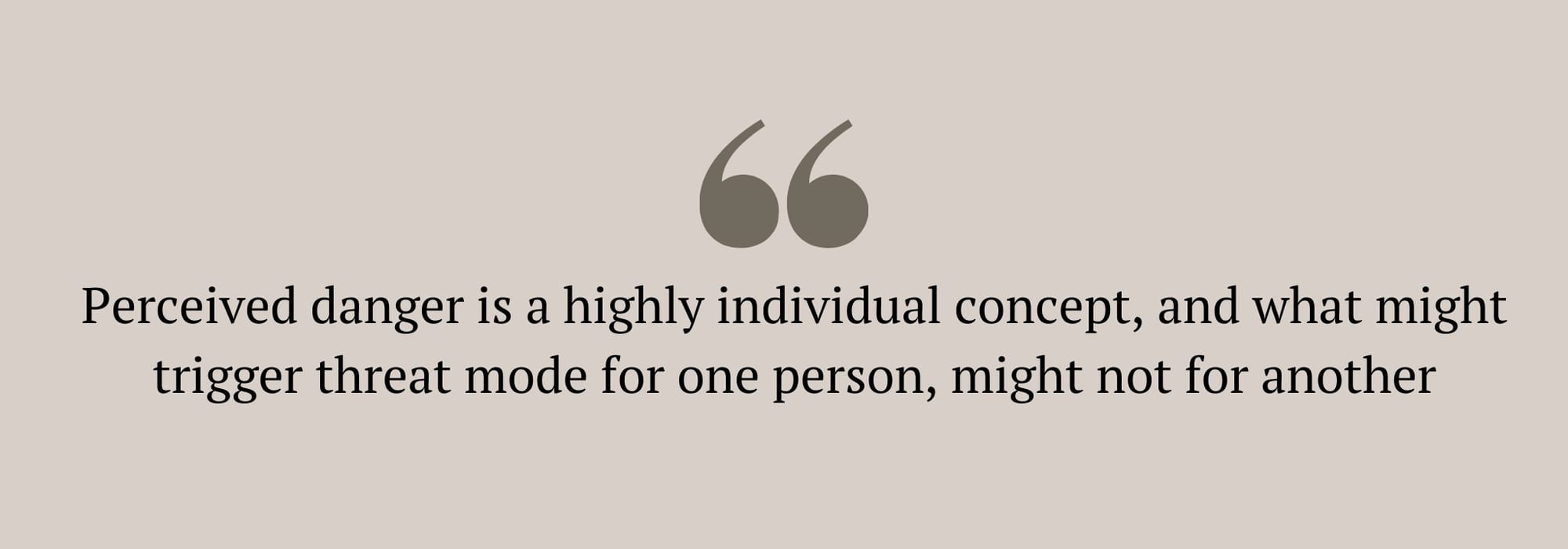Here's how to take back control when you feel your brain and body on high alert
Imagine something scary just happened. Maybe you’ve been asked to stand up and say a few words at an event, completely off the cuff. Perhaps you’ve witnessed something unsettling on the tube. Or you’ve found yourself in an unexpected argument.
How would you react? You might not know the answer right now. Often we can’t predict exactly how we’ll respond to a particular situation until it happens.
However, when you’re feeling particularly frightened, you might find yourself in threat mode: a natural response that places your body and brain on high alert, even when there’s no real cause for alarm.
This survival mechanism triggers a lot of hormonal and physiological processes that ensure you can act quickly when you’re genuinely in danger – by jumping out of the way of a moving vehicle or running away from a growling dog, for example.
“When we interpret a situation as threatening, lots of physical responses occur inside our bodies,” says psychotherapist Tania Taylor. “You might feel anxious, nervous, frightened, angry, or stressed. You could even cry, feel nauseous, or get butterflies in your stomach. This happens because our mind has interpreted a situation as dangerous, and so it makes changes to the body to help us survive a threat.”
When you’re in threat mode, you’re likely to act in one of four different ways: fight, flight, freeze, or fawn. Essentially, you’ll fight the danger, run from it, become immobilised, or attempt to make it better.
Whatever your response, Tania says these reactions are part of our evolutionary make up, and were perfect back in our caveman days when the threat of being attacked by a wild animal was much higher.
Today, though, the likelihood of fending off a passing wolf or any other threatening creature is low, and threat mode becomes tricky when you feel that fight, flight, freeze, or fawn reaction in response to something that poses no real danger, like an uncomfortable social situation or an upcoming job interview.

Not only does it feel very scary and unpleasant, it can prevent you from stepping outside of your comfort zone in the future. It’s hard to be brave when you feel under threat, and if something scares us once, we’re unlikely to expose ourselves to it again.
Here’s the thing: perceived danger is a highly individual concept, and what might trigger threat mode for one person, might not for another. That’s because your likelihood of experiencing threat mode is contingent on lots of different things, e.g. you’re more likely to have an exaggerated threat response if you’ve experienced a traumatic event or have an anxiety disorder.
So, is it possible to prevent threat mode? “We don’t ever want to prevent our survival mode from being able to occur when it’s needed,” Tania says. “If there’s a tiger in our kitchen, we want our flight response to kick in immediately so we feel stronger and can run away faster.”
However, when it comes to everyday stress – like speaking up in a meeting or dealing with conflict – you’re likely to find responding as though you’re in a life-or-death situation unhelpful.
“In this instance, introducing ways to alleviate stress and empty our metaphorical stress bucket on a regular basis can be helpful,” says Tania. There are many ways to do this, and it’s important to find what works best for you. It could be regular exercise or fresh air, journaling to process your feelings, or using meditation to induce calm.
Tania says learning to manage your levels of stress can make a massive difference. “We all know how much a good night’s sleep can impact on our ability to cope with the day ahead. Anxiety is very similar. If we are regularly living with anxious feelings, constantly feeling under threat despite not having our life threatened, we might find that it’s more difficult to cope with an additional stressful event.”
Basically, Consistently keeping your stress levels in check can make you feel calmer and more capable if and when a potentially threatening event arises.
Say it’s already too late. You’re faced with a perceived danger and you’ve found yourself in threat mode. Here are Tania’s in-the-moment tips:
1. Use a grounding technique to reconnect with your senses.
“Ask yourself: what can I hear, see, smell, touch, and taste,” Tania advises. This anchors you to the present moment, and serves as a distraction from the distress, giving your body time to calm down.
2. Explore breathing exercises.
“Try counting your breath, and with each subsequent breath, gently slow it down until it feels right for you,” Tania suggests.

3. Cuddle with someone who makes you feel safe.
Cuddling activates the parasympathetic nervous system, and promotes feelings of relaxation and calm. But don’t be deterred if there’s no one close to you around, as even wrapping your arms around yourself can help. Research shows a self-hug can alleviate anxiety by releasing endorphins and calming the nervous system.
Knowledge is often power, and many times, when we understand why we react the way we do and normalise it, we take away much of its power. By understanding threat mode and remembering that it’s your body’s way of keeping you safe, those daily stressors won’t seem quite so frightening.


Comments